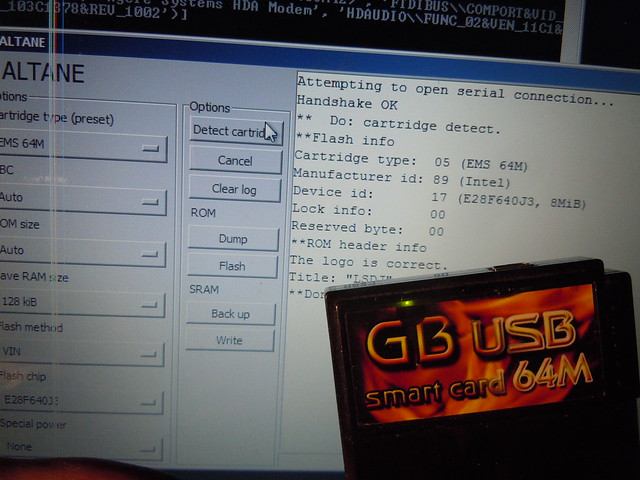bit 9 wrote:What is the purpose of the copper sticker on the back of the PCB?
Most likely just to provide a lower impedance ground path to the full circuit, plus perhaps shielding, perhaps for regulatory reasons. Belts and braces type of stuff.
bit 9 wrote:Does the cap with unregulated power directly over the amp (C2) affect the audio coming out if it?
C2 and (I think from the schematic) C9 are connected from the respective amplifier output (pins 12 and 15) to ground, and provide some high frequency attenuation, so yes, they do affect the quality of the sound. (In the neutral meaning of the word quality.)
bit 9 wrote:What's the significance of the six soldered holes near the top of the board?
The Gameboy Wideboy development unit gives a hint. This development unit has a dummy piece for the Gameboy, with no CPU, but buttons and an LCD. Those same holes exist there, but have silkscreen marked out. They are intended for capacitors, for some overshoot limiting or so. However, they are not populated even in this dev unit.
bit 9 wrote:Why are there leads from the screen socket going nowhere?
Those are test pads for probing the video signals. On older DMG motherboards they are exposed to so you can probe them, but they remain in later revisions as vestigial traces. I would recommend exposing them if anyone for any reason want to probe the video signals.
bit 9 wrote:The rectangular stop masks on the back are for grounding the screen’s PCB, what are the circular ones for?
You may have been looking too long at the schematic compared to a real motherboard. 
The round ones are for attaching the copper sticker.
bit 9 wrote:How dost one safely remove the DMG’s screen?
The connection point to the PCB is mechanically fragile. You want to make sure that all solder is molten before you lift it. Your best bet is likely hot air, but be very careful to not damage the LCD or LCD ribbon interconnect.
bit 9 wrote:How dost one safely re-attach the DMG’s screen?
With love and tender care. 
bit 9 wrote:Can anyone ID the parts on the power regulation aux board? (is this right?)
It should be about right, but good luck ever finding a suitable transformer new. You're likely better off designing a power regulator board from scratch.
bit 9 wrote:Why are there jumpers (?) on the back of the screen’s board?
The LCD board, despite being double sided, does not have through-plated vias. So those are indeed jumpers. On a modern PCB, just replace them with a track going on the bottom, connected on each end to the other side with a via. Note that one of the links (the one with two end on the bottom side) is not an electrical link, but a mechanical placeholder for the LCD ribbon cable.
bit 9 wrote:What would you want to change/add to the DMG’s circuitry to aid the musician/modder?
Prosound. A footprint for an LCD signal inverter for a biversion mod using a 6 pin dual inverter. Arduinoboy. Maybe replace the headphone amplifier with something more modern and less noisy. Maybe a rechargeable LiPo battery, assuming this can be done safely. If you want to get funky, an analog audio filter like http://www.youtube.com/watch?v=9KDI3UbW_3w.
bit 9 wrote:Is there anyone on this forum that would be willing to work collaboratively on an modded PCB?
*raises hand*
bit 9 wrote:Also, I don't actually know about the accuracy of the CPU/RAM pinouts and wouldn't know where to start. Can anyone corroborate this?
Should be about right, except maybe the naming of the display data pins, and the CLK? pin, which I believe isn't really a clock pin at all, but a gate signal specifying that there's bus activity.

